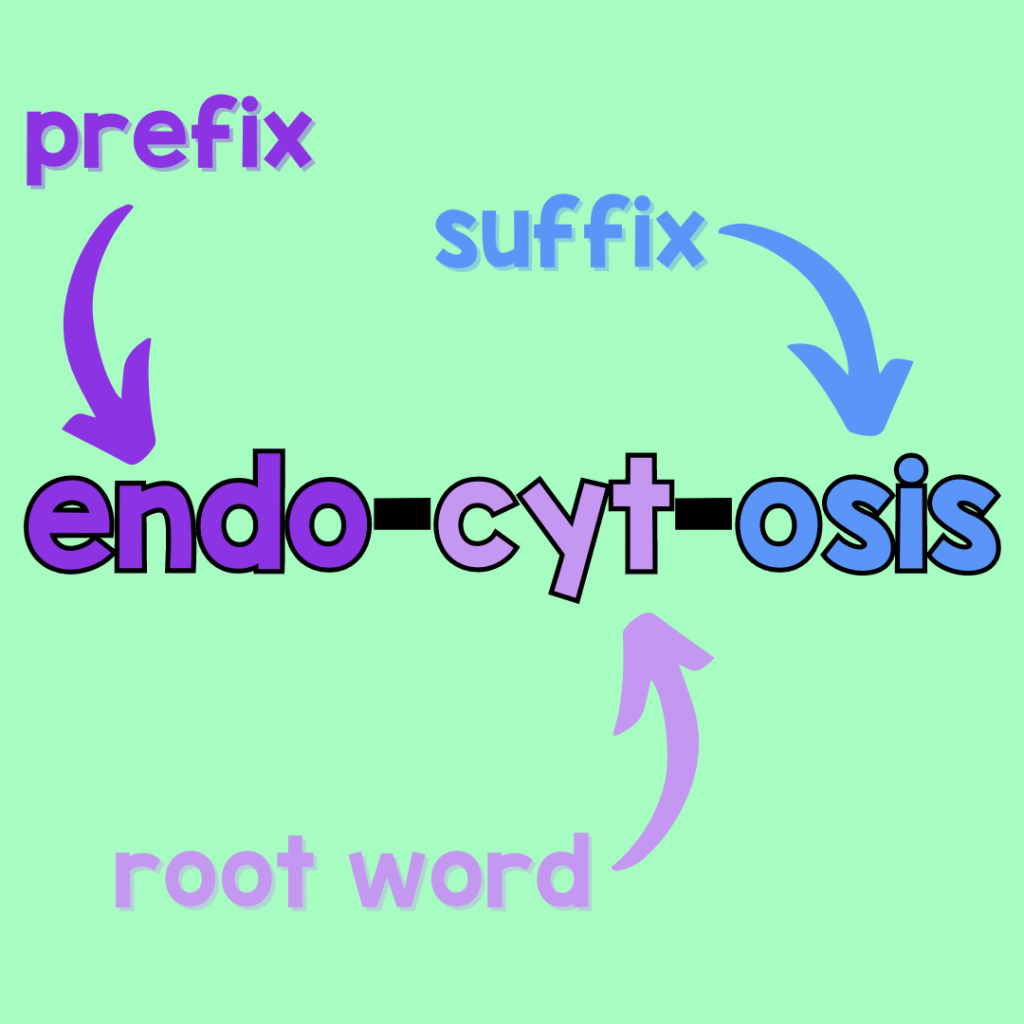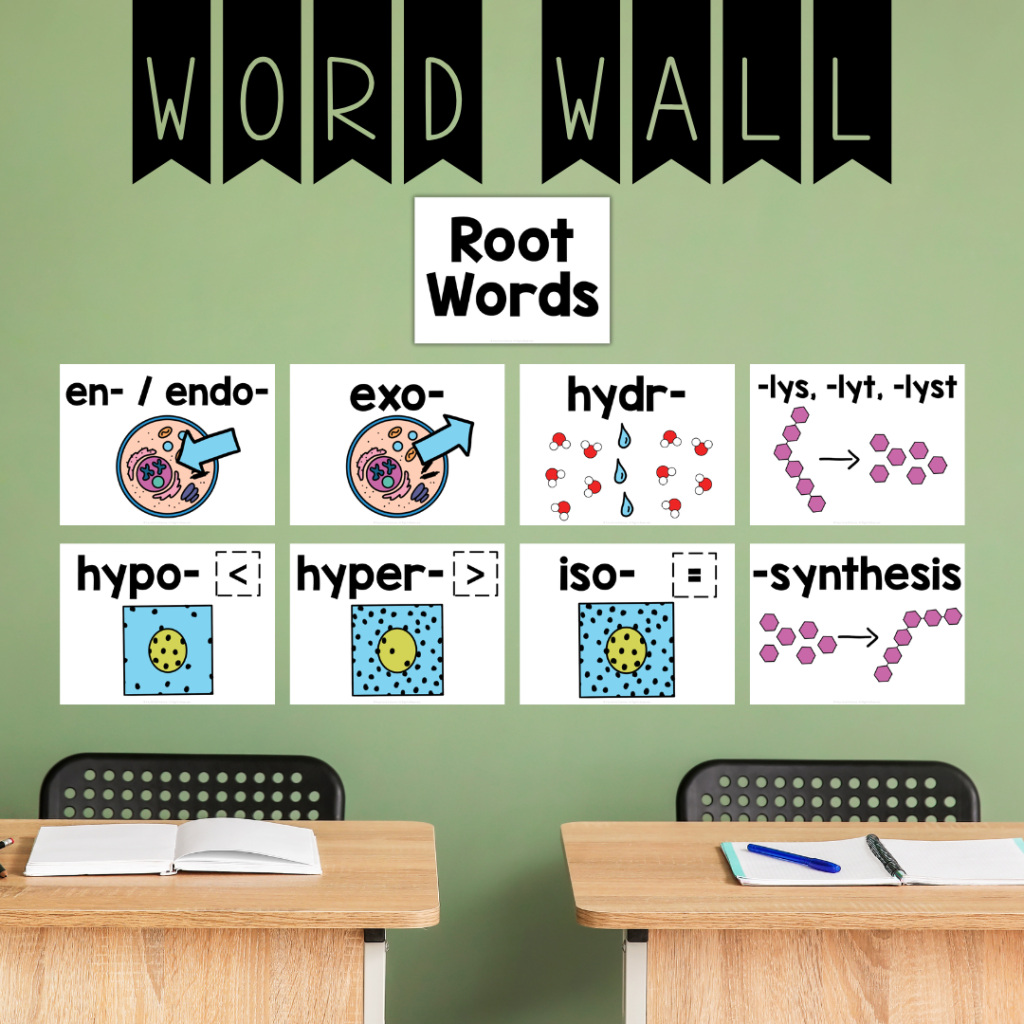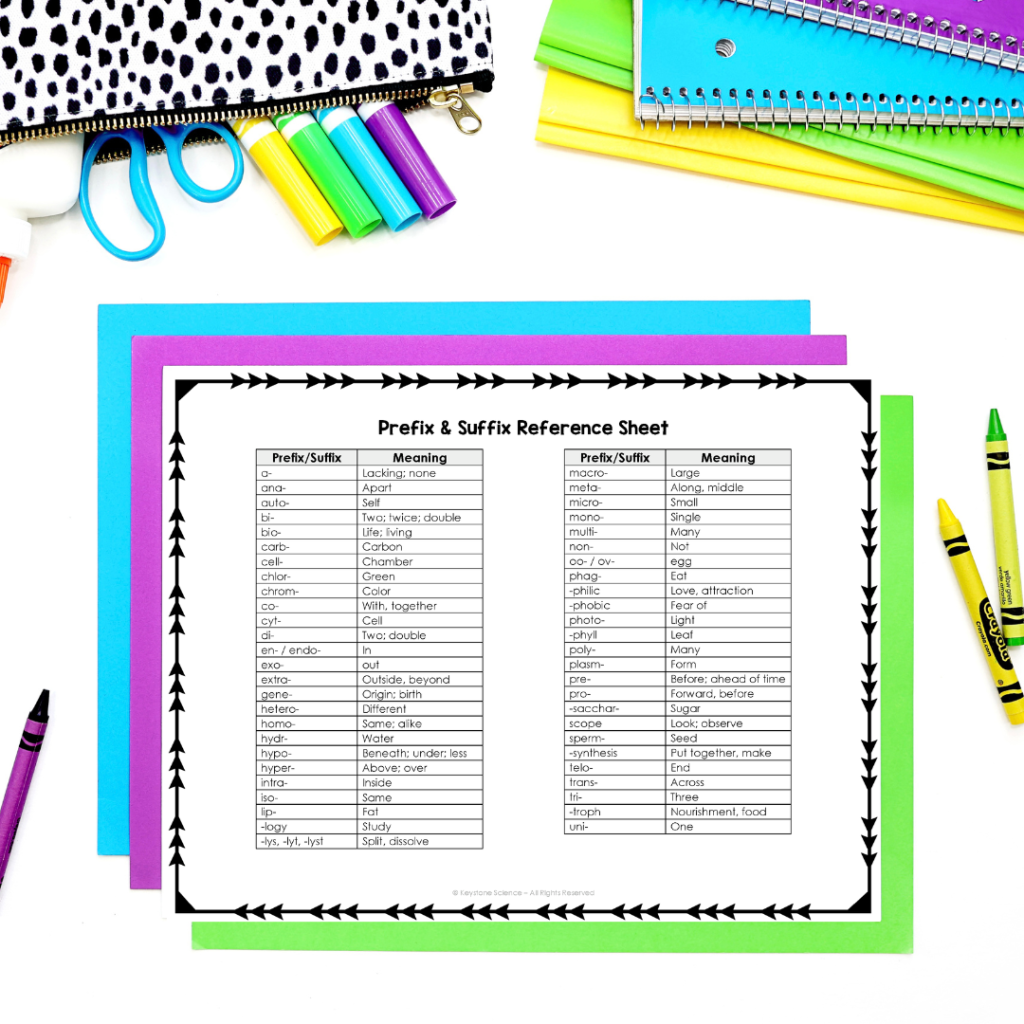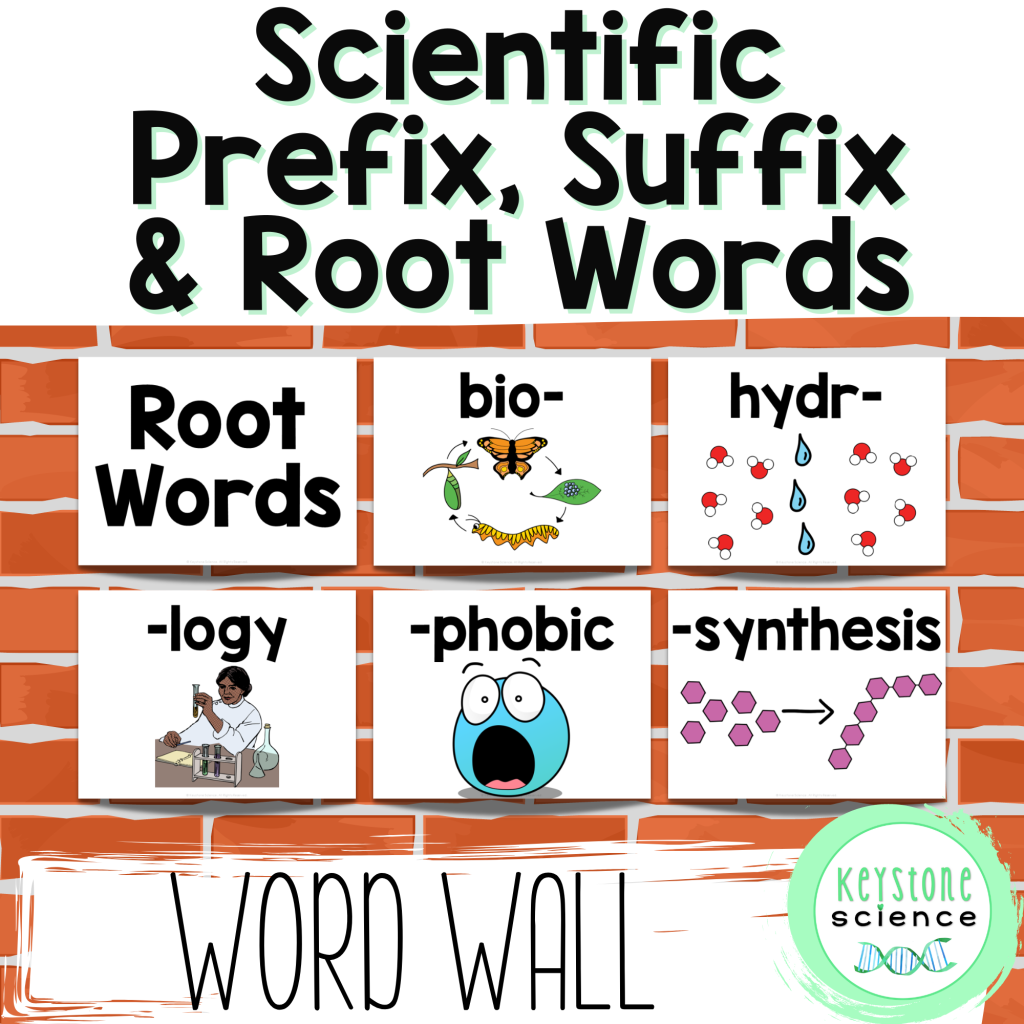Approximately 50-60% of words in English derive from Greek and Latin, and as science teachers, we know that many of those are science vocabulary words! Look at the mere title of science teacher… Science is derived from the Latin word scientia, which means to know.
With this in mind, students are in fact learning a new language when they are in our science classes and problems arise with learning a new language. Students may feel overwhelmed and have difficulty retaining vocabulary, and when knowledge transfer is supposed to occur, students struggle with the application of science vocabulary words in different contexts.
Similar to learning any new language some solutions are tried-and-true! One of the most significant aspects is learning and understanding word origins, particularly Greek and Latin roots. Once students understand the roots they can move forward to decode complex science vocabulary words in a wider variety of contexts.

Problem 1: Overwhelming Vocabulary in Science
With that significant percentage of words derived from Greek and Latin, it’s no wonder students feel overwhelmed by the new vocabulary they encounter in science courses. That feeling of overwhelm tends to lead students to memorize terms, which we know might be helpful for a short period but it doesn’t lead to long-term understanding.
Rote memorization means students can’t apply them in different contexts. Not being able to transfer science vocabulary words from one context to another means that each unit becomes a larger hill to climb.
There is a solution to this problem!
Solution 1: A strategy to help combat this overwhelm is to break down the terminology by teaching Greek and Latin roots, prefixes, and suffixes. Knowing the parts that make up the whole will reduce the cognitive load because students will understand terms based on their components.
For example, exo derives from the Greek word ekso, which means outside, while the word endo is endon in Greek and means inside. Students who know this would be able to differentiate between exocytosis and endocytosis with ease.
Another example is the Latin prefix con-/com-, which means with or together whereas dis-/dif- means apart or in different directions. A word that begins with either prefix provides a clear clue for students to decode.
Knowing Greek and Latin roots, prefixes, and suffixes will help students understand the meanings of more science vocabulary words than they would be able to memorize specifically.
Problem 2: Difficulty in Retaining Scientific Vocabulary Words
Retention of learning is an ongoing issue for all students in all subjects. When students cannot retain knowledge such as science vocabulary words this affects the possibility of building additional knowledge and understanding.
Because scientific vocabulary is abstract in nature and lacks connection with everyday language, it is more difficult to preserve the required vocab. This means students often forget terms or struggle in assessments.
Solution 2: Connecting Greek and Latin roots with every day terms or science vocabulary words can create connections in the brain that make it easier to recall terms. Many Greek and Latin roots are often repeated across different scientific terms, reinforcing learning and aiding memory retention.
The Greek root geo means related to earth or land. The Merriam-Webster dictionary lists 322 terms that begin with the root geo!
But students won’t need to memorize 322 different science vocabulary words with this prefix. Instead, by learning one single root – geo – they can decipher any number of terms in questions such as:
- What does a geologist study?
- What is the focus in the field of geology?
- Where do geophytes grow?
Tapping into their knowledge of Greek and Latin roots means that they can transfer this knowledge when they encounter ‘unknown’ words in different contexts.

Problem 3: Inability to Decode Unfamiliar Terms During Exams
The most highly charged place for students is usually during tests and exams. Student anxiety is high in those situations already but add in encounters with unfamiliar terms and there’s a significant effect on their performance.
This means students might misinterpret a question and record an incorrect answer even if they understand the underlying concept. In that instance, students’ performance trumps students’ knowledge.
Solution 3: By teaching students to use their knowledge of Greek and Latin roots to infer the meanings of unfamiliar terms on the spot they will be empowered to approach challenging questions with more confidence. The anxiety of taking a test or exam may not disappear but it won’t be compounded.
An example of an unfamiliar term that students could decode using their knowledge of roots, prefixes, and suffixes is any word that includes the suffix -phobia With their knowledge of the suffix phobia students would know it means a fear of something. Another possibility is the prefix hydro- that should lead students to know it’s about water or photo- would lead students to think about light.
How to Teach Greek and Latin Roots in the Science Classroom
Knowing the benefits of teaching Greek and Latin roots is one thing, teaching them is another. This three-step approach for science teachers is a strategy that will lead to direct support of student learning.
Step 1: Introduce Key Roots, Prefixes, and Suffixes
At the start of a science course, it’s a great idea to provide a list that shares the most common roots used in scientific terms. Create a foundation of key roots, prefixes, and suffixes students will encounter throughout the course. Knowing 10-20 specific ones will reduce that feeling of being overwhelmed.

As new units begin, revisit particular ones students will encounter, which leads to step 2.
Step 2: Practice with Real Science Vocabulary Words
After introducing the most common aspects of Greek and Latin, use activities to give students practice breaking down and analyzing scientific terms.
Starting this early and doing it often means students gain confidence in applying their knowledge in different contexts. They will recognize those key roots, prefixes, and suffixes in a wider array of science vocabulary words.
As the year progresses and you teach cell transport, you can reteach the prefixes hypo-, hyper-, iso, exo-, and endo-, which will help students decode and remember science vocabulary words that will be important for the unit.
Step 3: Reinforce Learning Through Repetition
And finally, to promote retention use games, quizzes, and flashcards to keep these concepts fresh and engaging.
This can be done with online quizzes such as a quick set-up in a program such as Kahoot, Blooket, or Gimkit.
Gamify it even more but without the tech set-up by providing students with sticky notes and then setting a timer and sharing a single root, suffix, or prefix. Ask students to list as many words as they can think of that contain the given root word.
Add in a bit of movement in class by having students line up opposite another student. Provide a set of flashcards of the different Greek or Latin roots, prefixes, or suffixes that are evenly divided between the two students. They can quiz each other and whenever one of them gets an answer right they take a step apart. It’s a quick and fun bit of movement in class that keeps things fresh and it’s a way for teachers to quickly see who might need more practice (less steps apart) and who is on the right track (greater distance between students).
Conclusion
Teaching Greek and Latin roots, prefixes, and suffixes in science classes is an ideal way to combat students’ feelings of overwhelm and their struggles with knowledge transfer and retention.
Incorporating root-based learning into vocabulary instruction improves scientific literacy. To make it easier for students (and teachers like you!) I created this Language of Biology Vocabulary Prefix and Suffix Worksheet. Get students thinking about science vocabulary words for biology, environmental science, or any general science courses you teach!
For more ideas to include scientific literacy, check out this post with 5 Reasons You Should Incorporate Book Studies in Your Science Classroom and this one with 22 Books to Use in Scientific Books Studies!
Looking Ahead
In our ongoing series about literacy in the science classroom, my next post will focus on AI literacy and its growing importance in science education. We know students know about and are using AI but they don’t always know the best ways to use it! We’ll explore ways to include AI respectfully and responsibly.
Let’s Connect!
💡Feel free to explore Keystone Science for ready-to-use high school biology & ecology NGSS aligned notes and activities.
💡Subscribe to my email list for weekly tips direct to your inbox.
💡Follow me on Instagram for daily tips, motivation, and facts you can use in your classroom!
🌟Share in the comments or email me directly 👉🏻 [email protected]















